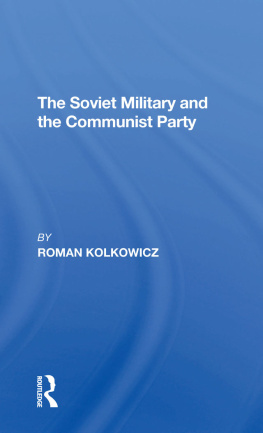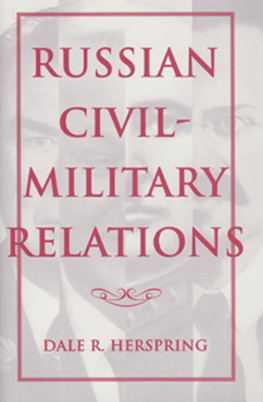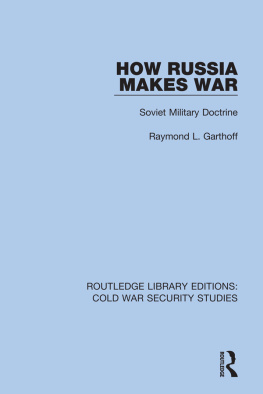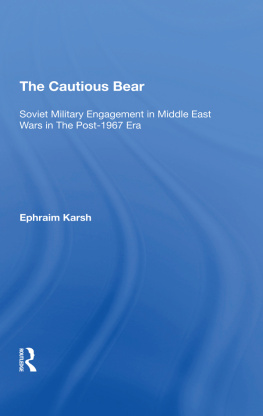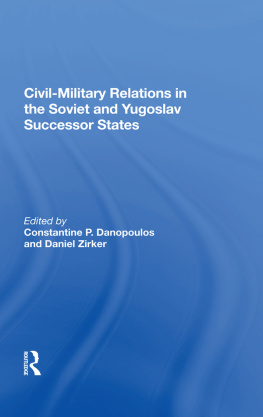Gorbachev and His Generals
First published 1990 by Westview Press
Published 2018 by Routledge
52 Vanderbilt Avenue, New York, NY 10017
2 Park Square, Milton Park, Abingdon, Oxon OX14 4RN
Routledge is an imprint of the Taylor & Francis Group, an informa business
Copyright 1990 by Taylor & Francis
All rights reserved. No part of this book may be reprinted or reproduced or utilised in any form or by any electronic, mechanical, or other means, now known or hereafter invented, including photocopying and recording, or in any information storage or retrieval system, without permission in writing from the publishers.
Notice:
Product or corporate names may be trademarks or registered trademarks, and are used only for identification and explanation without intent to infringe.
Library of Congress Cataloging-in-Publication Data
Gorbachev and his generals : the reform of Soviet military doctrine / edited by William C. Green and Theodore Karasik.
p. cm.
ISBN 0-8133-7898-2
1. Soviet UnionMilitary policy. 2. Gorbachev, Mikhail
Sergeevich, 1931. 3. Civil-military relationsSoviet Union.
I. Green, William C., 1941. II. Karasik, Theodore William.
UA770.G665 1989
322.50947dc20
8929113
ISBN 13: 978-0-367-01456-8 (hbk)
Contents
William F. Scott
, William C. Green
, Thomas Nichols and Theodore Karasik
, Fred Wehling
, Daniel Goure
, Stephen J. Blank
, Patrick Cronin
Paula J. Dobriansky and David B. Rivkin, Jr.
, William C. Green
, Thomas Nichols
, Grey Burkhart
, Randall E. Newnham
Guide
This collection of works is built around a common theme: how the reforms and political currents sweeping through Soviet society relate to the many indications of change in Soviet military doctrine. At first glance, the relationship is clean the Soviet military is undergoing changes similar in nature to those in the rest of the Soviet political and social structure. But as the chapters in this book make clear, there is a far more subtle dynamic taking place that bears heavy implications for the future of U.S.-Soviet relations. As a result, this book is intended for a much larger circle of readers than specialists in Soviet political-military relations. Ideally, it should be of value to all readers interested in long-term Soviet approaches to strategic issues.
In his five years as General Secretary of the Communist Party of the Soviet Union, Mikhail Gorbachev has launched initiatives that are leading to major changes in Soviet government, economy, and society. These changes have already begun to touch the military, and it is possible that the next decade could see the Soviet Armed Forces dramatically transformed. One factor that could accelerate, delay, or derail this process of changes is Soviet military doctrine.
Doctrine is a term that requires explanation, since it is used differently by the Soviet and American Armed Forces. In the Soviet sense it indicates the formal Party-military consensus over the external threats facing the Soviet Union, the approaches by which they are countered, and the resources and organization needed by the Armed Forces to react to them. The Party apparently adopted the use of doctrine in this sense, as a contract with the military, in the late 1950s.
For the next twenty years, Soviet military doctrine apparently remained relatively stable. The strategic and technological environment underwent considerable changes in this period. But the Soviet military responded with gradual and piecemeal modifications to military doctrine rather than major revision. By the early 1980s, many American analysts were detecting signs of dissatisfaction with existing doctrine in Soviet military writings. They felt that at the point of Gorbachevs accession to power Soviet military doctrine was at last being subjected to major revision.
Gorbachevs personal and far-reaching approach to reform raises many questions in regard to his relations with the Soviet military. Some of the most important include issues such as whether military doctrine is guiding Soviet military reform or simply catching up with it, how the Soviet military intends to match its diminishing share of resources to its increasing need for high technology, and how the ideological strictures that have confined the Soviet military can be maintained under conditions of glasnost. The most significant, of course, are the issues of how closely the Soviet military supports Gorbachevs policies of reforms, what degree of control Gorbachev maintains over the Soviet military, and whether the military leadership could lend their support to Gorbachevs opponents.
The editors decided to produce this book after long discussions at two conferences, the October 1988 Air Force Intelligence Agency Conference on Soviet Affairs in Washington, D.C., and the November 1988 conference of the American Association for the Advancement of Slavic Studies in Honolulu, Hawaii. We felt that a current work needed to be assembled that would address the foregoing questions, and we developed an outline that in our opinion connected most of the issues associated with Gorbachevs reforms and Soviet military doctrine.
We would like to thank our colleagues who participated in the debates surrounding the issues found within this book, for as the reader will discover, the views presented here are diverse. However, it is important to point out that the opinions expressed in this book are those of the authors and do not represent the views of their employers or sponsors; they accept full responsibility for the content, finally, we want to thank our wives, Ann Green and Eve Karasik, for their support and understanding.
William C. Green
Boston, Massachusetts
Theodore Karasik
Los Angeles, California
1
Soviet Military Doctrine: Continuity and Change?
William F. Scott
Is Soviet military doctrine now of a purely defensive character? Are Soviet forces maintained only at a level of reasonable sufficiency? Kremlin leaders make major efforts to convince the outside world that fundamental changes are occurring in Soviet military policies. They are heralded as part of General Secretary Mikhail Gorbachevs new thinking.
But there is nothing new in these expressions. Gorbachevs predecessors implemented these slogans to change Western perceptions of Soviet military power. What is new is the skill of the public relations campaign to sell Gorbachev as the driving force behind glasnost and perestroika. To confuse the situation further, many words have different meanings in the Soviet Union than in the West. Military doctrine is a case in point.
In the United States military doctrine simply is a set of principles for the use of forces in combat. We have a Navy doctrine, tactical doctrine, Air Force doctrine, and so on.
In contrast, in the Soviet Union military doctrine is the military policy of the Communist Party of the Soviet Union (CPSU). Its edicts have the force of law. As stated by Marshal of the Soviet Union Nikolai Ogaikov, military doctrine is to answer the following five questions:
- What is the degree of probability of future war, and with what enemy will one have to deal?
- What character might the war take that the country and its Armed Forces might have to wage?


